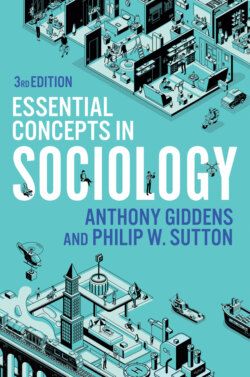Читать книгу Essential Concepts in Sociology - Anthony Giddens - Страница 80
Meaning and Interpretation
ОглавлениеSocial constructionism is very widely adopted in sociology and involves piecing together all the elements which have brought about a specific social phenomenon, such as gender or crime. Constructionism challenges conventional wisdom and common-sense ideas in so far as these accept the existence of, say, gender and crime as natural or normal. For social constructionists, gender and crime are created through historical social processes and social interactions. Of course, this means that gender and crime are not fixed and can be shown to have changed, in both meaning and form, over time and across societies. In this way, social constructionism is rooted in the idea that society and its institutions are always in process, and the task of sociology is to investigate this constant process.
Not all constructionist approaches are the same, and a basic distinction has been made between ‘strong’ and ‘weak’ forms, a distinction lifted from SSK. However, recently this distinction has been reframed as a contrast between ‘strict’ and ‘contextual’ constructionism, which appears to be more neutral. Strict constructionists argue that neither nature nor society presents itself in unmediated form. All phenomena are accessible only through human concepts and theories, and these are open to change – sometimes quite radical change. Strict constructionists are a small minority of constructionists. The vast majority of constructionist studies are happy to acknowledge that there is a reality that is external to sociologists’ discourse, but what is at issue is how we gain access to it. Contextual constructionists have much to say about social and environmental problems and the claims that social groups make about them, pointing out that what cannot be accepted at face value is the existing hierarchy of social problems. Some problems seem very urgent and in need of attention, but others appear relatively trivial and can be safely ignored. Contextual constructionists take the present ordering of social problems as the starting point. Does this ordering actually reflect the seriousness of society’s problems? Sociology can perform a useful role in investigating the arguments made by ‘claims-makers’ and ‘claimsdeniers’, and sociologists can thereby ensure that all the information needed for a rational evaluation can be put into the public domain.
A good example of how constructionists work is Hannigan’s (2014) study of the environmental problem of biodiversity loss, which rose rapidly to prominence in the 1980s. Biodiversity loss had been known about since at least 1911, evidenced by numerous legislative attempts to protect threatened birds and animals. But no international institutions existed to give such concerns a political focus. What changed in the 1980s was the involvement of multinational business looking to patent genetic resources – such as species within rainforests – the creation of a new ‘crisis’ discipline of conservation biology, the establishment of a United Nations infrastructure that gave the necessary political focus, and a raft of legislation to preserve species. In short, a much more effective range of ‘claims-makers’ had an interest in making this demand, and their combination brought the subject to the top of the environmental problems agenda. Of course, there were also some claims-deniers, but on this occasion the claims-makers proved too strong and well organized. Only a constructionist account which pays attention to the historical construction of this claim is able to show clearly how and why it was successful.
